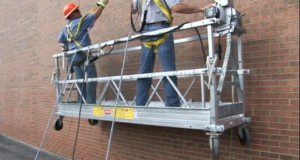 Workers can suffer serious injuries and death when access equipment is improperly used. Lack of training and non-compliance with manufacturer’s instructions are often the cause of these incidents.
Workers can suffer serious injuries and death when access equipment is improperly used. Lack of training and non-compliance with manufacturer’s instructions are often the cause of these incidents.
From August 1 to August 31, 2011, Ministry of Labour inspectors conducted a blitz of hazards involving all types of access equipment at Ontario constructions sites. Inspectors checked on compliance with theOccupational Health and Safety Act (OHSA) and its regulations.
The blitz focused on the appropriate selection of access equipment and its safe and proper use. This included an equipment audit.
The goal was to:
- raise awareness of access equipment hazards
- encourage employers to identify and control hazards
- address and remedy non-compliance with the OHSA and its regulations
- deter non-compliant employers
- enhance health and safety partnerships, and
- promote improved health and safety for workers using access equipment.
Report summary
Between 2003 and 2008, more than one-third of fatal falls involving construction workers involved access equipment. In total, 61 construction workers died from falls at construction sites. Of those, 24 fatalities involved access equipment.
On December 24, 2009, four workers fell 13 storeys to their deaths when a swing-stage came apart at a Toronto construction site. A fifth worker survived the fall. This incident prompted a review of Ontario’s occupational health and safety system which led to recommendations for major changes that are currently being implemented by the ministry.
In August 2011, ministry inspectors conducted 998 visits to 903 workplaces and issued 2,955 orders under the OHSA, including 243 stop-work orders.
More than 16 per cent of the orders were for contraventions related to the unsafe use of access equipment.
The most commonly issued orders were for lack of adequate supervision and training, and inadequate implementation of a well functioning internal responsibility system (IRS).
Read the Full Report
Inspection activity
From August 1 to 31, 2011, MOL inspectors conducted 998 visits to 903 workplaces and issued 2,955 orders under the OHSA, including 243 stop-work orders.
The following table provides an overview of the blitz results:
| Construction Sector Access Equipment Blitz August 1 – 31, 2011 |
Total Construction Sector Enforcement Activity (including the blitz) August 1 – 31, 2011 |
|
|---|---|---|
| Number of workplaces visited | 903 | 1,889 |
| Total workplace visits | 998 | 2,298 |
| Orders (all types) | 2,995 | 5,723 |
| Stop-work orders | 243 | 538 |
| Orders per workplace visit | 2.96 | 2.49 |
| Stop-work orders per workplace visit | 0.24 | 0.23 |
Order analysis
Orders were issued for various violations under the OHSA and Regulation for Construction Projects during the blitz.
The highest percentage of orders issued (16.6 per cent) involved unsafe use of access equipment. A blitz of low-rise residential construction projects had similar findings in May 2011, with the highest number of orders (17.2 per cent) involving unsafe use of access equipment.
The table below includes the top six most frequently issued orders during the August 2011 access equipment blitz:
| Reason for order | Number of orders | Percentage of total orders issued |
|---|---|---|
| Safe Use of Access Equipment[1] | 490 | 16.6% |
| Fall Protection | 313 | 10.6% |
| Personal Protective Equipment[2] | 254 | 8.6% |
| Stop Work Order | 239 | 8.1% |
| Administrative Requirements[3] | 239 | 8.1% |
| Housekeeping | 109 | 3.7% |
| Written Emergency Procedures | 103 | 3.5% |
Conclusion
The results indicate safe use of access equipment and fall protection continue to be the two major health and safety concerns related to access equipment on construction projects. Inspectors also noted a lack of compliance with personal protective equipment and housekeeping requirements.
These findings demonstrate a need for increased worker supervision and a better understanding of legislative knowledge among supervisors. The absence of basic safety-related personal protective equipment also demonstrates a need for increased importance to be placed on fundamental safety practices on construction projects. The relatively high percentage of orders related to emergency procedures (seventh on the list of most issued orders) is an indicator that workers are not exercising their OHSA rights to know, participate and refuse unsafe work.
There is a need for increased engagement in health and safety practices among all workplace parties. Employers should focus on training, self-compliance, personal protective equipment, fall protection, utilizing tools and equipment as per manufacturers’ instructions, hazard assessments and emergency procedures.
Discussion
No comments yet.